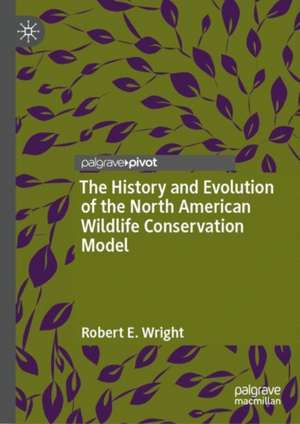The History and Evolution of the North American Wildlife Conservation Model
Autor Robert E. Wrighten Limba Engleză Hardback – 16 iun 2022
Preț: 384.31 lei
Nou
Puncte Express: 576
Preț estimativ în valută:
73.53€ • 76.78$ • 60.72£
73.53€ • 76.78$ • 60.72£
Carte tipărită la comandă
Livrare economică 15-29 aprilie
Preluare comenzi: 021 569.72.76
Specificații
ISBN-13: 9783031061622
ISBN-10: 3031061624
Pagini: 130
Ilustrații: XI, 130 p. 2 illus.
Dimensiuni: 148 x 210 x 16 mm
Greutate: 0.33 kg
Ediția:1st ed. 2022
Editura: Springer International Publishing
Colecția Palgrave Macmillan
Locul publicării:Cham, Switzerland
ISBN-10: 3031061624
Pagini: 130
Ilustrații: XI, 130 p. 2 illus.
Dimensiuni: 148 x 210 x 16 mm
Greutate: 0.33 kg
Ediția:1st ed. 2022
Editura: Springer International Publishing
Colecția Palgrave Macmillan
Locul publicării:Cham, Switzerland
Cuprins
1. The Problem of Policy Persistence.- 2. The North American Wildlife Conservation Model and Its Discontents.- 3. History of the North American Wildlife Conservation Model.- 4. The Dangers of Democracy.- 5. Proxy Hunting and Other Second-Best World Policy Proposals.- 6. Conclusion.
Notă biografică
Robert E. Wright is Senior Faculty Fellow at the American Institute for Economic Research, USA.
Textul de pe ultima copertă
This book explains how six policies collectively called the North American Wildlife Conservation Model (NAWCM), put in place around the turn of the twentieth century, saved numerous iconic big game species from extinction. Rigid adherence to the NAWCM, however, especially its ban on the commercial sale of wild game meat, has allowed deer and some other species to become overabundant pests in areas where hunting pressure recently declined and habitat rebounded. Texas and South Africa have proven that scientific insight and market incentives can combine to prevent game overabundance and decrease the fragility and extend the range of iconic mammal game species. This book outlines how intermediate steps, like proxy hunting and other wildlife regulation reforms, could be used to lure more hunters into the field and move other states towards the Texas model incrementally, thereby minimizing risks to wildlife or human stakeholders.
Robert E. Wright is Senior Faculty Fellow at the American Institute for Economic Research, USA.
Caracteristici
Assess the successes and failures of the North American Wildlife Conservation Model Draws on business, economic, environmental, and policy histories Suggests a new policy, termed proxy hunting, that could ensure the achievement of scientific management harvest quotas
